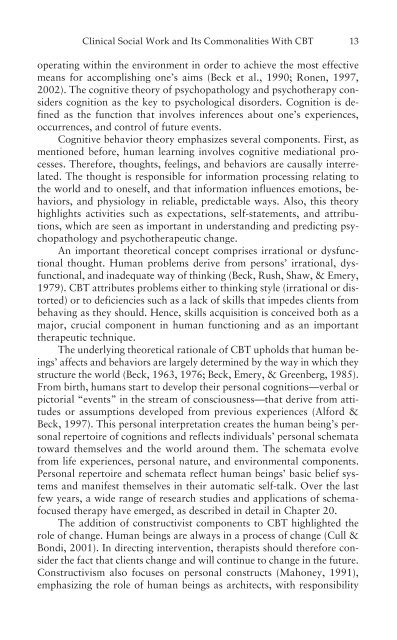Tammie Ronen, PhD - Springer Publishing
Tammie Ronen, PhD - Springer Publishing
Tammie Ronen, PhD - Springer Publishing
You also want an ePaper? Increase the reach of your titles
YUMPU automatically turns print PDFs into web optimized ePapers that Google loves.
xxii<br />
INTRODUCTION<br />
States in the late 19th and early 20th centuries. With the postsettlement<br />
house movement, the Mary Richmond style “casework” approach (i.e.,<br />
social diagnosis), social work as a profession began to flounder in terms<br />
of its identity. As it grasped at ideas about the goals, foci, and its potential<br />
client groups, social work moved more toward the fields of psychology<br />
and psychiatry, and social work practice began to mimic a medical<br />
model. This was especially true of clinical social work. Social workers<br />
saw clients as “patients” and their problems came to be defined through<br />
“diagnosis.” Clinical social workers developed credentialing systems to<br />
certify that a “clinical” social worker was not the same as a “degreed” social<br />
worker. Clinical social workers were trained in individual, family,<br />
and group therapy, and could be found working in private practice, institutions,<br />
schools, and mental health settings.<br />
Contemporary social work has moved away from the medical model<br />
in part because of the perceived negative effects of labeling attendant to<br />
diagnoses and in recognition of social/contextual issues that impact human<br />
capacities. Within social work today, there is greater emphasis placed on<br />
social policy development, reduction of oppressive systems and forces,<br />
and addressing environmental constructs that impair individual and community<br />
health. Social work has always been a profession that was interested<br />
in helping people change, trying to bridge gaps in society and<br />
addressing the needs of the weak, the voiceless, and the disenfranchised.<br />
SOCIAL WORK AND CBT<br />
Whether working in clinical practice, private practice, or institutional settings,<br />
public agency, policy, or administration social workers have become<br />
the backbone of mental health practice in most settings. Clinicians<br />
recognize the need for a model of treatment that is active, short-term,<br />
directive, problem-oriented, solution-focused, collaborative, structured,<br />
dynamic, and psychoeducational interventions. CBT meets that need.<br />
Contemporary mental health circumstances require the provision of highquality<br />
services to as many individuals as possible. Dwindling resources<br />
and limitations of financial supports have had the consequences of decreased<br />
space, staff, and ability to provide services. As both a clinical issue<br />
and one of social policy, the use of a cognitive behavior model seems ideally<br />
constructed and consistent with the needs of social workers. As <strong>Ronen</strong><br />
points out, there has been a shift in the position of the clients from the<br />
passive recipients of service to being active partners in their treatment.<br />
One of the most significant characteristics of CBT is its dynamic<br />
nature. It is dynamic in many ways. First is the manner in which CBT<br />
is continually subjecting itself to an evaluation process. What works?

















